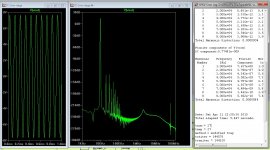No expectations just curiosity - I'd be interested to know at what impedance the measurements do change. Subjectively power supply impedance (when circuitry's not pure classA, balanced) makes a difference to my ears, objectively I dunno.
My (limited) experience with super-pair was some instability of this "compound" at very HF. Like the diamond. How do-you address-it ?A prime example of added complexity affecting the "personality" of the
semiconductors is the Baxandall (super-pair)/Hawksford VAS on my last
"attempt".
The Hawksford nearly eliminates the early effect "personality"... and the
Baxandall eliminates load , saturation , reduces Cbb.
All this for just a benign added pole. GOOD tradeoff.
Did-you compared *in listening* with a simple VAS to see if nothing lost in micro dynamic and if the added complexity is worth the effort?
My timestep=numsample
numsample is ( .param numsampl=simtime/Freq/((simtime/numcyc)*FFT).
Variable ?
OS
Increase the FFT parameter by 2 or 3.
My (limited) experience with super-pair was some instability of this "compound" at very HF. Like the diamond. How do-you address-it ?
Did-you compared *in listening* with a simple VAS to see if nothing lost in micro dynamic and if the added complexity is worth the effort?
- In listening , both a more "airy" ,and transparent nature.
-in Abuse , tubelike clipping - low in "nasties". 😀
-electrically , no load on preceding stage , Baxandall "self clamps" -
stays cool ... but with those
extra leds/ BC550/560 , more traces -pads. 😱
price of glory = 4 leds + 4 15 cent BCxxx's .
OS
OS
Increase the FFT parameter by 2 or 3.
OK ... I crippled this line-stage.
Rser= 2R and FFT= 65536 (X4) , load = 33R.
THD went up a bit , still real low (below).
Residual "hash" became finer >100K , tried all of LT's 5$+
low noise FET input op-amps ... all below 1ppm any frequency.
Only allowing the buffer into class B could get me "normal"
distortion readings.
OS
Attachments
No expectations just curiosity - I'd be interested to know at what impedance the measurements do change. Subjectively power supply impedance (when circuitry's not pure classA, balanced) makes a difference to my ears, objectively I dunno.
The buffer should be pure class A @ 100ma bias.
Enough to run an amp input and maybe even headphones.
OS
Dado you`ve made that masking effect type of amplifier 🙂
I don't think so, distortion is very low to do that.
OK ... I crippled this line-stage.
Rser= 2R and FFT= 65536 (X4) , load = 33R.
THD went up a bit , still real low (below).
Residual "hash" became finer >100K , tried all of LT's 5$+
low noise FET input op-amps ... all below 1ppm any frequency.
Only allowing the buffer into class B could get me "normal"
distortion readings.
OS
OS
2R are emitter resistors on the output?
True. Keeps me off the street though.
Which is as good a reason as any to dabble in audio electronics. Even if you think all amps sound the same (which I don't) I really like to try out new circuits, new concepts, doing thinks different that I think are better. Still fascinates me after decades of tinkering.
Jan
OS
2R are emitter resistors on the output?
Nope ,Series resistance instead of an ideal voltage source.
10r emitters and a 33r load.
OS
Thanks OS. I will explore this more deeply.- In listening , both a more "airy" ,and transparent nature.
While fighting against distortion of output stages in AB seems more urgent (to me;-).
Last edited:
Nope ,Series resistance instead of an ideal voltage source.
10r emitters and a 33r load.
OS
Got that, thanks 😱
Last edited:
Frank came up with a 100W SE tube amp with 0.01% THD at full power; Menno introduced a transconductance stage combined with a common cathode tube stage and Guido produced what must be the perfect cathode follower.
Jan, will these appear in LA?
Also, as I frequently rationalize, techniques that may spring from audio investigations may find application in other fields, like scientific instrumentation.Which is as good a reason as any to dabble in audio electronics. Even if you think all amps sound the same (which I don't) I really like to try out new circuits, new concepts, doing thinks different that I think are better. Still fascinates me after decades of tinkering.
Jan
Also, as I frequently rationalize, techniques that may spring from audio investigations may find application in other fields, like scientific instrumentation.
Don't know about that, but I've seen the reverse many times.
Jan, will these appear in LA?
Dimnitri, Frank's circuit is included in his Vol 8 article. Guido's new circuits will be in Vol 10.
Menno has a small book out called 'Trans', appropriately: Elektor Vanderveen Trans Tube Amplifiers Elektor
Jan
For 24bit lovers here is some FREE music. Piano Day Happy Piano Day welcome to the first holiday which celebrates the piano Nils Frahm is clearly barking, which I approve of and the piano he is playing here Model 370 should be extreme enough for anyone. Download is a wav so will take a few minutes unless you are on a bad boy fat pipe.
When it comes to best linearization of class AB output stages, I think that Bob Cordell's book has the most explicit description of what is necessary to get the best transition between class A and class AB that anyone can read about.
- Status
- Not open for further replies.
- Home
- Member Areas
- The Lounge
- John Curl's Blowtorch preamplifier part II
